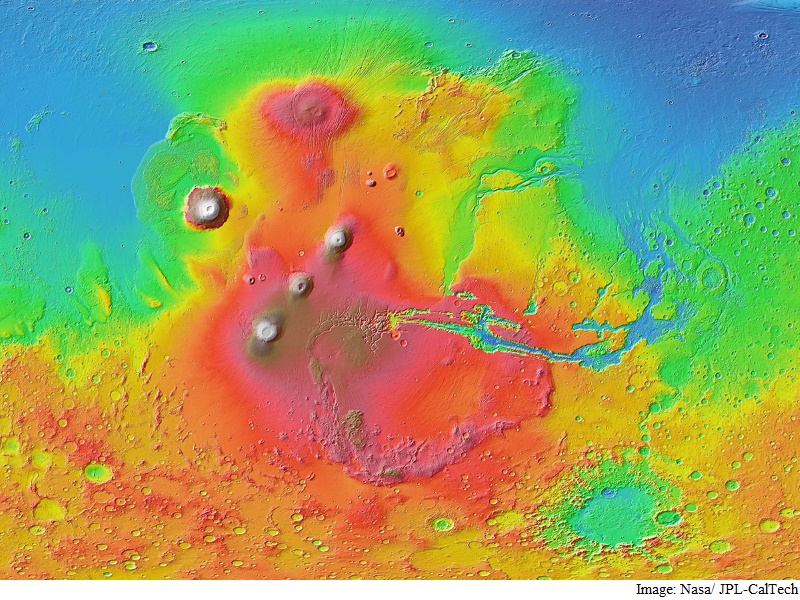- Home
- Science
- Science News
- Two Large Meteorites Hit Mars 3.4 Billion Years Ago, Caused Tsunamis: Study
Two Large Meteorites Hit Mars 3.4 Billion Years Ago, Caused Tsunamis: Study

About 3.4 billion years ago, a big meteorite impact triggered the first tsunami wave.
"This wave was composed of liquid water. It formed widespread backwash channels to carry the water back to the ocean," said Alberto Fairen, visiting scientist in astronomy at Cornell University.
The scientists found evidence of another big meteorite impact which triggered a second tsunami wave.
In the millions of years between the two meteorite impacts and their associated mega-tsunamis, Mars went through frigid climate change, where water turned to ice.
"The ocean level receded from its original shoreline to form a secondary shoreline, because the climate had become significantly colder," Fairen added.
The second tsunami formed rounded lobes of ice.
These lobes froze on the land as they reached their maximum extent and the ice never went back to the ocean - which implies the ocean was at least partially frozen at that time.
"Our paper provides very solid evidence for the existence of very cold oceans on early Mars," the authors noted.
These icy lobes retained their well-defined boundaries and their flow-related shapes, meaning the frozen ancient ocean was briny.
"Cold, salty waters may offer a refuge for life in extreme environments, as the salts could help keep the water liquid... If life existed on Mars, these icy tsunami lobes are very good candidates to search for biosignatures," Fairen said.
"We have already identified some areas inundated by the tsunamis where the ponded water appears to have emplaced lacustrine sediments, including evaporites," added lead author Alexis Rodriguez of the Planetary Science Institute in Arizona.
"As a follow-up investigation, we plan to characterise these terrains and assess their potential for future robotic or human in-situ exploration," he noted in Scientific Reports, a publication of the journal Nature.
Catch the latest from the Consumer Electronics Show on Gadgets 360, at our CES 2026 hub.
Related Stories
- Samsung Galaxy Unpacked 2025
- ChatGPT
- Redmi Note 14 Pro+
- iPhone 16
- Apple Vision Pro
- Oneplus 12
- OnePlus Nord CE 3 Lite 5G
- iPhone 13
- Xiaomi 14 Pro
- Oppo Find N3
- Tecno Spark Go (2023)
- Realme V30
- Best Phones Under 25000
- Samsung Galaxy S24 Series
- Cryptocurrency
- iQoo 12
- Samsung Galaxy S24 Ultra
- Giottus
- Samsung Galaxy Z Flip 5
- Apple 'Scary Fast'
- Housefull 5
- GoPro Hero 12 Black Review
- Invincible Season 2
- JioGlass
- HD Ready TV
- Laptop Under 50000
- Smartwatch Under 10000
- Latest Mobile Phones
- Compare Phones
- Honor Magic 8 RSR Porsche Design
- Honor Magic 8 Pro Air
- Infinix Note Edge
- Lava Blaze Duo 3
- Tecno Spark Go 3
- iQOO Z11 Turbo
- OPPO A6c
- Samsung Galaxy A07 5G
- Lenovo Yoga Slim 7x (2025)
- Lenovo Yoga Slim 7a
- Lenovo Idea Tab Plus
- Realme Pad 3
- Moto Watch
- Garmin Quatix 8 Pro
- Haier H5E Series
- Acerpure Nitro Z Series 100-inch QLED TV
- Asus ROG Ally
- Nintendo Switch Lite
- Haier 1.6 Ton 5 Star Inverter Split AC (HSU19G-MZAID5BN-INV)
- Haier 1.6 Ton 5 Star Inverter Split AC (HSU19G-MZAIM5BN-INV)







![[Sponsored] Haier C90 OLED TV | Dolby Vision IQ, 144Hz OLED and Google TV in Action](https://www.gadgets360.com/static/mobile/images/spacer.png)









